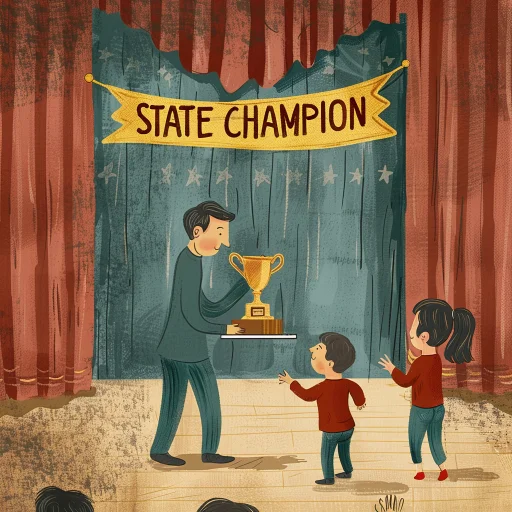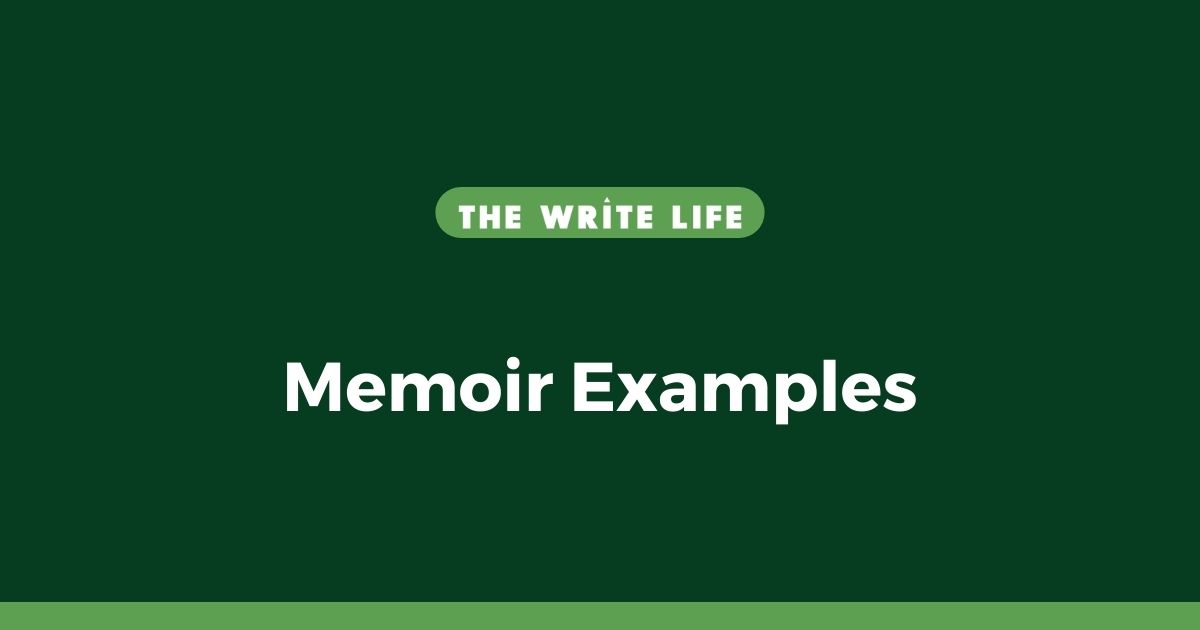Imagine holding a mirror to your life where every reflection tells a story, some so vivid and profound they could only be believed because they are true.
This is the essence of memoir, a genre that turns personal experiences into a universal language of emotions, lessons, and discoveries.
As writers, delving into memoirs is more than a pastime—it’s an exploration into the art of storytelling through the lens of real-life adventures, struggles, and triumphs.
We’ll explore 33 memoir examples from some of the most popular types, giving you a feel for the diversity of the genre and the writing lessons to take from these beloved books.
What is a memoir example?

A memoir example is an example of a published book that chronicles the author’s personal experiences, offering insights into their life’s pivotal moments, emotions, and lessons learned.
Unlike autobiographies, which may aim to document each phase of a person’s life, memoirs tend to focus on a specific theme, period, or series of events, painting a detailed picture of the human condition through a personal lens.
This focus enables memoirs to resonate deeply, bridging the gap between the author’s world and the reader’s.
Memoirs stand out because they prioritize storytelling over chronological history.
They invite readers into the author’s world, sharing the emotional journey rather than just the facts.
This narrative approach enriches the reader’s experience, making each memoir a unique exploration of life’s complexities.
What are the benefits of studying memoir examples?
So why should you take the time to study these memoir examples and learn the lessons they contain?
Only by studying successful memoirs can you have the right mix of knowledge and inspiration to write your own.
Some of the most compelling reasons to become a student of the memoir genre include:
- Enhanced empathy: By walking a mile in another’s shoes through their memoir, you gain insights into lives and perspectives vastly different from your own. This exercise in empathy enriches your understanding of the human experience, broadening your worldview.
- Improved writing skills: Analyzing the narrative structure, voice, and character development in memoirs sharpens your writing. Each memoir serves as a masterclass in storytelling, offering lessons in crafting compelling narratives that engage readers.
- Diverse perspectives: Memoirs open windows to varied cultural, social, and personal landscapes, encouraging you to explore themes and stories beyond your immediate experiences. This diversity fuels creativity, inspiring fresh ideas and approaches in your writing.
- Emotional connection: Learning how authors convey their most intimate experiences helps you harness the power of emotional storytelling. This connection is vital in writing that resonates with readers, making your work memorable.
- Authentic voice development: Memoirs exemplify the importance of an authentic voice in storytelling. Studying them helps you find and refine your unique voice, an essential element in distinguishing your writing in a crowded space.
Now that you have a solid grasp of the benefits that studying memoirs offers, let’s delve deep into the first of our eleven memoir types, showcasing three pertinent examples and the lessons you can learn from each.
1 – Memoir examples of early life stories

Early life memoirs explore the foundational years that shape individuals, offering a deep dive into the experiences and influences that forge character, resilience, and perspective.
These memoirs are a testament to the lasting impact of youth on personal growth and identity.
The Glass Castle by Jeannette Walls
This memoir provides a raw, unflinching look at Walls’ nomadic, poverty-stricken childhood with her dysfunctional family. It’s a story of resilience in the face of chaos and neglect.
Aspiring memoir writers can learn from Walls’ ability to recount her experiences with honesty and without self-pity.
Her narrative teaches the power of a clear, straightforward storytelling style, proving that the strength of a memoir lies in the truth of its tales, however harsh they may be.
Educated by Tara Westover
Westover’s journey from growing up in a strict, survivalist family in Idaho to earning a PhD from Cambridge University is a compelling exploration of self-transformation and the quest for knowledge.
Writers should note Westover’s skillful handling of complex family dynamics and her journey to education and self-awareness.
The memoir demonstrates how to weave personal growth with broader themes of education and freedom, offering a blueprint for balancing personal narratives with universal questions.
This Boy’s Life by Tobias Wolff
Wolff’s memoir of his adolescence captures his experiences with a volatile stepfather and his desperate, often misguided attempts to escape a bleak home life.
From Wolff, writers can learn the importance of reflective insight and the nuanced portrayal of characters, including oneself, in memoir writing.
His candid exploration of his younger self’s flaws and misadventures serves as a lesson in the value of vulnerability and honesty in crafting a compelling narrative.
2. Memoir examples of adventure and exploration books
Adventure and exploration memoirs plunge readers into the heart of the unknown, sharing the author’s journeys through uncharted territories, both external and internal.
These stories are not just about the places visited but the personal transformations that occur along the way.
Into the Wild by Jon Krakauer
Krakauer tells the story of Christopher McCandless, a young man who abandoned his possessions to explore the Alaskan wilderness, ultimately leading to his tragic end. This memoir explores themes of freedom, nature, and the search for meaning.
Writers can learn from Krakauer’s meticulous research and narrative framing, illustrating how to blend biography with personal anecdote and analysis.
This memoir is a masterclass in building suspense and maintaining reader engagement through detailed, evocative descriptions of the natural world and the human spirit.
Wild by Cheryl Strayed
Strayed’s memoir recounts her solo hike along the Pacific Crest Trail, undertaken in a moment of personal crisis. It’s a story of physical endurance and emotional healing, as the journey brings her face to face with her past and her fears.
For memoir writers, Wild showcases the power of a personal journey to drive a narrative.
Strayed’s frank and poignant prose demonstrates how to balance introspection with action, making her external journey a mirror for internal change.
The Motorcycle Diaries by Ernesto “Che” Guevara
Before he became a revolutionary, Guevara embarked on a youthful motorcycle journey across South America with his friend Alberto Granado. This memoir is a blend of adventure and emerging social consciousness.
Aspiring writers can draw inspiration from Guevara’s evocative descriptions and the way he weaves social and political observations into his personal narrative.
This memoir exemplifies how travel can be a catalyst for personal and ideological transformation, teaching writers to infuse their stories with broader themes beyond their immediate experience.
3. Examples of cultural and social identity memoirs

Memoirs focusing on cultural and social identity delve into the complexities of belonging, exploring how background, society, and personal choices converge to shape one’s sense of self. These stories are vital for understanding diverse perspectives and experiences.
The Year of Magical Thinking by Joan Didion
Didion reflects on the year following the sudden death of her husband, exploring themes of grief, love, and memory. Her precise, stoic prose captures the disorienting nature of mourning and the struggle to find meaning in loss.
Writers can learn from Didion’s controlled use of language and structure to convey deep emotion and introspection.
This memoir teaches the art of writing about pain without succumbing to sentimentality, using clarity and reflection to touch readers deeply.
Born a Crime by Trevor Noah
Noah’s memoir of growing up in post-apartheid South Africa provides insight into the complexities of navigating identity in a place where he was literally born a crime. The book is a mix of humor, history, and personal anecdote.
Memoir writers can glean from Noah the skill of balancing light-heartedness with serious social commentary.
His ability to tell stories that are both entertaining and enlightening demonstrates how personal narratives can serve as a powerful lens on societal issues.
Hunger: A Memoir of (My) Body by Roxane Gay
Gay’s memoir is a profound exploration of body image, weight, and the intersectionality of identity and self-worth. Her candid account discusses her relationship with her body, trauma, and the societal expectations of femininity.
This memoir offers lessons in writing about deeply personal and potentially divisive topics with grace and honesty.
Gay’s forthrightness and vulnerability encourage writers to tackle their truths head-on, showing that personal specificity can resonate universally.
4. Examples of memoirs about overcoming adversity
Memoirs of overcoming adversity showcase the human spirit’s resilience in the face of challenges, be they physical, psychological, or societal.
These narratives provide hope and inspiration, demonstrating the power of perseverance and the possibility of triumph through trials.
A Long Way Gone: Memoirs of a Boy Soldier by Ishmael Beah
Beah recounts his harrowing experience as a child soldier in Sierra Leone, offering a poignant testament to the devastations of war and the capacity for healing. His story is a journey from loss and violence to redemption.
Writers can learn from Beah’s straightforward yet evocative storytelling style, which captures the horrors of war without sensationalism.
His memoir is a lesson in the power of narrative to foster understanding and empathy for experiences far removed from most readers’ lives.
The Glass Castle by Jeannette Walls
This memoir provides a raw, unflinching look at Walls’ nomadic, poverty-stricken childhood with her dysfunctional family. It’s a story of resilience in the face of chaos and neglect.
Aspiring memoir writers can learn from Walls’ ability to recount her experiences with honesty and without self-pity.
Her narrative teaches the power of a clear, straightforward storytelling style, proving that the strength of a memoir lies in the truth of its tales, however harsh they may be.
Educated by Tara Westover
Westover’s journey from growing up in a strict, survivalist family in Idaho to earning a PhD from Cambridge University is a compelling exploration of self-transformation and the quest for knowledge.
Writers should note Westover’s skillful handling of complex family dynamics and her journey to education and self-awareness.
The memoir demonstrates how to weave personal growth with broader themes of education and freedom, offering a blueprint for balancing personal narratives with universal questions.
5. Memoir examples focused on tales of career and professional life

Memoirs within the career and professional life category offer insights into the joys, struggles, and lessons learned on the path to professional achievement and personal fulfillment.
These stories inspire by showing the myriad ways one can navigate, succeed, and sometimes falter in their chosen field.
Kitchen Confidential by Anthony Bourdain
Bourdain pulls back the curtain on the culinary world with his candid, no-holds-barred look at his life as a chef. The book is a blend of personal journey and industry exposé, filled with humor, wisdom, and a love for food.
For memoir writers, Bourdain’s unfiltered voice and vivid storytelling are lessons in how to capture the essence of a profession while weaving in personal narratives.
His book demonstrates the power of passion and authenticity in connecting with readers, showing that expertise mixed with personal reflection makes for compelling reading.
Just Kids by Patti Smith
Smith’s memoir chronicles her relationship with photographer Robert Mapplethorpe during their early years in New York City’s art scene. It’s a story of artistic growth, friendship, and the pursuit of creative expression.
Aspiring writers can learn from Smith’s poetic prose and her ability to capture the zeitgeist of a bygone era.
Her memoir exemplifies how personal stories can illuminate broader cultural and artistic movements, offering insights into the creative process and the bonds that fuel artistic innovation.
Shoe Dog by Phil Knight
Knight shares the story of building Nike from a small start-up to a global brand. His memoir is a candid account of the trials, errors, and triumphs encountered in the business world.
Memoir writers can glean insights from Knight’s honest reflection on his journey, showcasing the value of resilience, vision, and innovation.
His narrative teaches the importance of storytelling in entrepreneurship, illustrating how personal and professional experiences can inspire and inform others.
6. Examples of mental health and recovery memoirs
Memoirs in this category delve into personal battles with mental health, offering unvarnished insights into the struggles and triumphs of recovery.
These stories are vital, shedding light on often-stigmatized topics and offering hope and understanding to those facing similar challenges.
The Noonday Demon: An Atlas of Depression by Andrew Solomon
Solomon combines personal narrative with in-depth research to explore the landscape of depression. His book offers both a memoir of his own journey and a broader cultural and scientific examination of the condition.
Writers can learn from Solomon’s meticulous approach to blending personal experience with extensive research.
His work demonstrates how to discuss complex, sensitive topics with empathy and intelligence, making a compelling case for the power of personal stories to illuminate broader societal issues.
An Unquiet Mind by Kay Redfield Jamison
In this memoir, Jamison, a psychologist who specializes in bipolar disorder, shares her own experiences with the condition. Her unique perspective as both clinician and patient provides deep insights into the complexities of living with bipolar disorder.
Aspiring writers can draw inspiration from Jamison’s candid and poetic exploration of her mental health.
Her memoir underscores the importance of vulnerability and honesty in writing about personal struggles, showing how these qualities can foster a deeper connection with readers.
Darkness Visible by William Styron
Styron’s memoir stands as a profound account of his descent into depression and his journey toward recovery. His exploration of the condition is both deeply personal and universally resonant, offering solace and understanding to those affected by mental illness.
From Styron, writers can learn the art of conveying the indescribable aspects of mental health challenges.
His ability to articulate the ineffable experience of depression teaches the value of precise language and metaphor in exploring personal and complex subjects.
7. Family and relationships memoir examples

Memoirs about family and relationships examine the intricate web of connections that shape our lives.
These narratives explore love, loss, and the myriad ways in which our familial bonds and relationships define us.
Fun Home: A Family Tragicomic by Alison Bechdel
Bechdel’s graphic memoir navigates her complex relationship with her father, intertwined with her coming-of-age story and her coming out. The novel’s visual and textual layers add depth to the exploration of family dynamics, identity, and grief.
Memoir writers can learn from Bechdel’s innovative use of the graphic novel format to tell her story.
Her work exemplifies how combining visuals with text can enhance storytelling, offering new ways to engage with readers and delve into personal narratives.
The Year of Magical Thinking by Joan Didion
Didion reflects on the year following the sudden death of her husband, exploring themes of grief, love, and memory. Her precise, stoic prose captures the disorienting nature of mourning and the struggle to find meaning in loss.
Writers can learn from Didion’s controlled use of language and structure to convey deep emotion and introspection.
This memoir teaches the art of writing about pain without succumbing to sentimentality, using clarity and reflection to touch readers deeply.
Running with Scissors by Augusten Burroughs
Burroughs’ memoir of his unconventional and troubled childhood offers a humorous yet poignant look at family life. His vivid storytelling and sharp wit make the book a compelling read despite its dark themes.
Aspiring memoir writers can learn from Burroughs’ ability to blend humor with hardship.
His memoir demonstrates how to use wit as a tool for coping and storytelling, showing that even the most challenging experiences can be explored in ways that resonate with humor and heart.
8. Examples of travel and living abroad memoirs
Memoirs of travel and living abroad capture the thrill of discovering new places and cultures, often reflecting on how these experiences change the author.
These narratives offer readers a passport to distant lands and the internal journeys that accompany physical travel.
Under the Tuscan Sun by Frances Mayes
Mayes’ memoir about renovating a villa in Italy explores themes of home, discovery, and the pleasures of food and culture. Her evocative descriptions of Tuscany and the transformation of her villa mirror the personal growth and renewal she experiences.
Writers can learn from Mayes’ rich, sensory descriptions and her ability to weave personal transformation with a sense of place.
Her memoir exemplifies how setting can be a character in itself, deeply influencing the narrative and the author’s journey.
Eat, Pray, Love by Elizabeth Gilbert
Gilbert’s memoir chronicles her journey across Italy, India, and Indonesia, seeking self-discovery and spiritual fulfillment after a difficult divorce. Her honest and engaging narrative captures the essence of each culture and her path to finding balance and happiness.
Memoir writers can take note of Gilbert’s narrative arc, structured around the physical and emotional landscapes she navigates.
Her book shows how to frame a personal quest within the broader context of travel and exploration, making the journey relatable and inspiring.
The Geography of Bliss by Eric Weiner
Weiner’s memoir is an exploration of happiness across the globe, as he travels to the world’s happiest (and unhappiest) places. His witty, insightful observations provide a unique blend of travelogue and psychological inquiry.
Aspiring writers can learn from Weiner’s use of humor and research to engage readers.
His approach demonstrates how to blend personal narrative with a thematic quest, offering a compelling way to explore big questions through the lens of travel.
9. Examples of memoirs about celebrity and public life

Memoirs from celebrities and public figures pull back the curtain on the glitz and glamour, offering a glimpse into the realities of life in the spotlight.
These narratives explore the complexities of fame, success, and the personal journeys behind public personas.
Becoming by Michelle Obama
In this deeply personal memoir, Michelle Obama chronicles her life from her childhood in Chicago to her years as First Lady of the United States. She shares her triumphs and disappointments, both public and private, with unerring honesty and warmth.
Writers can learn from Obama’s narrative how to blend personal stories with historical and social contexts, creating a rich tapestry that is both intimate and universally appealing.
Her memoir demonstrates the power of authenticity and vulnerability in connecting with a wide audience.
Open by Andre Agassi
Agassi’s memoir is a candid account of his life on and off the tennis court, revealing the struggles and conflicts that accompanied his career. It’s a story of transformation and perseverance, offering insights into the pressures of professional sports.
Memoir writers can take away Agassi’s ability to confront his past with brutal honesty and reflect on his personal and professional growth.
His narrative shows the importance of introspection and the courage to change, providing a compelling model for writing about personal evolution.
Just as I Am by Cicely Tyson
Tyson’s memoir offers a sweeping view of her life and career, breaking ground as a Black actress in Hollywood and using her platform to advocate for racial justice. Her story is a testament to resilience, talent, and the power of living one’s truth.
From Tyson, writers can learn the art of intertwining personal achievements with broader social movements.
Her memoir exemplifies how to tell a personal story that is deeply entwined with cultural and historical milestones, inspiring writers to explore the intersection of individual and collective narratives.
10. Historical and political events memoir examples
Memoirs that intersect with historical and political events provide a personal lens on the moments that shape our world.
These stories offer a unique perspective on history, told through the eyes of those who lived through significant events.
Night by Elie Wiesel
Wiesel’s memoir of his experience with his father in the Nazi German concentration camps at Auschwitz and Buchenwald in 1944–1945, at the height of the Holocaust, is a poignant exploration of faith, humanity, and survival.
Writers can learn from Wiesel’s use of stark, simple language to convey profound truths about the human condition.
His memoir teaches the importance of bearing witness and the power of memory to honor those who were lost and to educate future generations.
I Know Why the Caged Bird Sings by Maya Angelou
Angelou’s memoir captures her childhood and adolescent years, facing racism and trauma in the American South. It’s a story of overcoming adversity and finding one’s voice against all odds.
Memoir writers can draw inspiration from Angelou’s lyrical prose and her ability to find strength and beauty in the face of hardship.
Her narrative demonstrates how personal stories can illuminate the broader struggles and triumphs of a community, encouraging writers to delve deep into their own experiences to find universal resonance.
Long Walk to Freedom by Nelson Mandela
Mandela’s autobiography chronicles his journey from his early years in a rural village to his inauguration as the first democratically elected President of South Africa. It’s a tale of resilience, leadership, and the fight for freedom.
Writers can learn from Mandela’s detailed recounting of his personal and political struggles, showing how to weave a compelling narrative that combines personal reflection with historical significance.
His memoir is a masterclass in writing about the intersection of personal life with larger political movements and ideals.
11. Examples of science and innovation memoirs

Memoirs in the realm of science and innovation offer insights into the minds of those who have pushed the boundaries of knowledge and technology.
These narratives explore the passion, curiosity, and challenges of pioneering new frontiers.
The Double Helix by James D. Watson
Watson’s account of the discovery of the DNA structure provides a behind-the-scenes look at scientific discovery, complete with the personal and professional dynamics that influenced the work. It’s a candid and sometimes controversial look at the process of scientific innovation.
Writers can learn from Watson’s engaging narrative style and his ability to make complex scientific concepts accessible and compelling.
His memoir encourages aspiring writers to find the human story within the scientific endeavor, highlighting the importance of persistence, creativity, and collaboration.
Silent Spring by Rachel Carson
Though more an environmental science book than a traditional memoir, Carson’s work interweaves personal observation with scientific analysis, sparking the environmental movement. Her powerful advocacy for the natural world changed public perception and policy regarding pesticide use.
Writers can take from Carson’s example the power of combining personal passion with research to advocate for change.
Her work demonstrates how writing can be a tool for raising awareness and inspiring action, urging memoir writers to consider the impact their stories can have on the world.
Surely You’re Joking, Mr. Feynman! by Richard P. Feynman
Feynman’s collection of anecdotes offers a glimpse into the life of the Nobel Prize-winning physicist, known for his brilliant mind and playful spirit. His stories reveal the curiosity and joy that drove his scientific exploration.
From Feynman, writers can learn the importance of infusing narratives with personality and humor, making even the most complex topics engaging and relatable.
His memoir shows that at the heart of innovation lies not just intellect but a profound sense of wonder and an ability to see the world differently.
Are you ready to apply lessons from these memoir examples to your own book?
Each of the memoir examples you’ve encountered holds lessons in resilience, insight, and the art of weaving personal truths into compelling tales. Now, armed with inspiration and insight from the masters, it’s time to tell your story.
Embrace the challenge of memoir writing with honesty and courage.
Your experiences, perspectives, and voice are unique treasures waiting to be shared.
Whether it unfolds in the quiet corners of introspection or the wide landscapes of extraordinary experiences, your story deserves to be told.
Start writing today. Let the wisdom gleaned from these memoirs guide you, but let your voice lead the way.
The world is waiting for your story.


